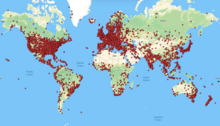Museum
A museum (/mjuːˈziːəm/ mew-ZEE-əm; plural museums or, rarely, musea) is a building or institution that cares for and displays a collection of artifacts and other objects of artistic, cultural, historical, or scientific importance.[1] Many public museums make these items available for public viewing through displays that may be permanent or temporary.[2] The largest museums are located in major cities throughout the world, while thousands of local museums exist in smaller cities, towns, and rural areas. Museums have varying aims, ranging from the conservation and documentation of their collection, serving researchers and specialists, to catering to the general public. The goal of serving researchers is not only scientific, but intended to serve the general public.
There are many types of museums, including art museums, natural history museums, science museums, local history museums, and children's museums. According to the International Council of Museums (ICOM), there are more than 55,000 museums in 202 countries.[3]
The English "museum" comes from the Latin word, and is pluralized as "museums" (or rarely, "musea"). It is originally from the Ancient Greek Μουσεῖον (Mouseion), which denotes a place or temple dedicated to the muses (the patron divinities in Greek mythology of the arts), and hence was a building set apart for study and the arts,[4] especially the Musaeum (institute) for philosophy and research at Alexandria, built under Ptolemy I Soter about 280 BC.[5]
The purpose of modern museums is to collect, preserve, interpret, and display objects of artistic, cultural, or scientific significance for the study and education of the public. From a visitor or community perspective, this purpose can also depend on one's point of view. A trip to a local history museum or large city art museum can be an entertaining and enlightening way to spend the day. To city leaders, an active museum community can be seen as a gauge of the cultural or economic health of a city, and a way to increase the sophistication of its inhabitants. To a museum professional, a museum might be seen as a way to educate the public about the museum's mission, such as civil rights or environmentalism. Museums are, above all, storehouses of knowledge.[citation needed] In 1829, James Smithson's bequest, that would fund the Smithsonian Institution, stated he wanted to establish an institution "for the increase and diffusion of knowledge".[6]
Museums of natural history in the late 19th century exemplified the scientific desire for classification and for interpretations of the world. Gathering all examples for each field of knowledge for research and display was the purpose. As American colleges grew in the 19th century, they developed their own natural history collections for the use of their students. By the last quarter of the 19th century, scientific research in universities was shifting toward biological research on a cellular level, and cutting-edge research moved from museums to university laboratories.[7] While many large museums, such as the Smithsonian Institution, are still respected as research centers, research is no longer a main purpose of most museums. While there is an ongoing debate about the purposes of interpretation of a museum's collection, there has been a consistent mission to protect and preserve cultural artifacts for future generations. Much care, expertise, and expense is invested in preservation efforts to retard decomposition in aging documents, artifacts, artworks, and buildings. All museums display objects that are important to a culture. As historian Steven Conn writes, "To see the thing itself, with one's own eyes and in a public place, surrounded by other people having some version of the same experience, can be enchanting."[8]


